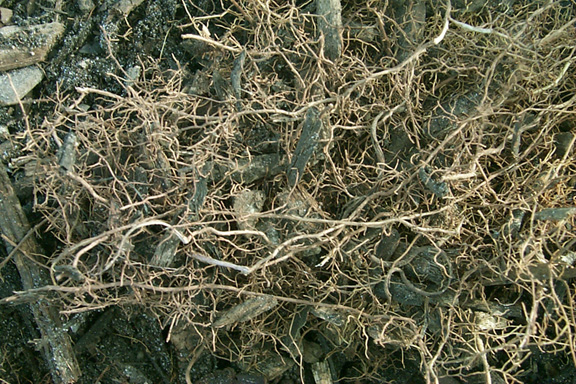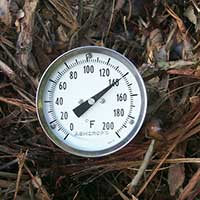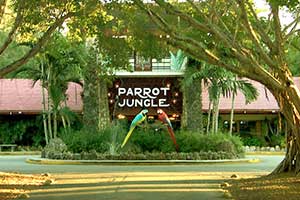
How the use of Compost and Mulch has been an Important Component of a Successful Integrated Pest Management Program

Conference Proceedings of the
Association of Zoological Horticulture
Orlando, Florida September 2001
Over the past decade I have developed an Integrated Pest Management Program (IPM) at Parrot Jungle and Gardens (PJG) that has enabled the 14 acre park to eliminate it's dependence upon restricted pesticides, fungicides, and nematicides. A significant reduction in commercial fertilizer use has also been achieved. The major components of this program are the adherence to specific cultivation techniques, such as selective pruning, (Shimonski 1991) closely monitored irrigation, and the use of mulch and our park-produced compost. The lessor components include the use of baits, such as Nosema for Grasshopper control, and occasional application of the different varieties of Bacillus thuringensis for caterpillar and mosquito control.
As the IPM program has evolved, so has the science and technology of composting. Originally PJG used composting only to reduce trash-hauling costs of animal-derived wastes and bedding. The compost was only used as fill. Currently all organic material (except food waste) produced park-wide is composted onsite (Shimonski 1996). The stabilized compost is now utilized as a soil additive throughout PJG and as the main component of the potting soil in our plant nursery (Freeman and Cawthon 1999, Wilson, et al. 2001). Hundreds of feet of berms have been built using compost. These are extra growing areas for plant material that will be relocated to the new park that PJG is now constructing. Our composting program at PJG recently won the 2001 Environmental Business Practices Award with the Greater Miami Chamber of Commerce.
My first experience with compost and its application was almost 30 years ago. I had a summer job in a plant nursery where part of my duties was the repotting of plants into larger containers. The soil used was sandy and coarse but also contained a good amount of dark organic material. I learned that the nursery owner made the soil by allowing a local sod company to dump unusable pallets of sod at the nursery where it was then mixed with the coarse sand. Once mixed it appeared to sit for many months before it was used as potting soil. The results were obvious; the plants seemed to be in good condition with minimal fertilization.
Two of the most traditional practices in farming are composting and the use of mulch as a top dressing (Thurston 1997). Composting is the simple practice of utilizing natural fungal and bacterial processes to create soil out of organic matter. The microbes that thrive during the decomposition process benefit plants as a source-sink of nutrients such as phosphorus and nitrogen. Also, large populations of some of these microbes have been shown to overwhelm or exclude pathogenic organisms in the rhizosphere or the root zone (Golley 1983; Zucconi and de Bertoldi 1987; Miller 2001). The composting process is also what happens to mulch as it breaks down. For a millennia, mulching or cover cropping has been utilized to return nutrients back into the soil thereby improving the microflora and microfauna of the rhizosphere.
The practice of mulching decreases water loss from the soil, keeps the soil temperature cooler, and by excluding sunlight from reaching the soil surface, inhibits weed growth. Cooling tropical soils by mulching can reduce soil temperature to a level more optimal for growth and activity of plants and microorganisms (SSSA 1987). It is the large body of research in these areas that has given me the incentive to experiment with compost and mulch applications in a variety of situations.
For many years at PJG most of the monocots such as palms, heliconias, and bananas have thrived when the ground around them was top-dressed with decomposing tree trimming mulch. These mulch beds are generally replenished three to four time a year. Other plants that do well growing in mulch are many species of bromeliads and aroids.
At PJG there is a lawn area of St. Augustine grass, Stenotaphrun secundatum, that covers about 3,000-sq. ft. Until last year it had to be replaced at least once or twice a year because of heavy pedestrian traffic. The lawn was also being fertilized on a quartly basis with a commercial 4-7-5 fertilizer. Last spring, when the entire lawn was replaced, three to four inches of our compost was applied to the bare ground and tilled into the thin layer of sandy soil before the new sod was laid down. Within three weeks there was already an obvious difference in the vigor and color of the new lawn. The grass was a dark green and remained in this healthy looking condition without fertilization for about nine months. When pedestrian traffic (that numbers in the tens of thousands) finally started to take its toll, we then fertilized with 4-7-5. Since research in the area of adding commercial fertilizer to compost (Jurgens 2001) has been very positive, the additional fertilizer application was done at half the strength to test the response of the grass. The results were visible in a couple of weeks. Once more there was increased vigor and good color. There was no need to apply more fertilizer.
The lawn remained healthy and did not need to be replaced for six more months. A soil organism biomass analysis was done by Soil Foodweb Inc. (SFI) in June 2001 that showed a high number of protozoa and bacteria in the lawn's rhizosphere. This amount of microfauna indicates good nutrient cycling and was most likely responsible for maintaining a constant source of nutrients for the grass enabling it to thrive under heavy pedestrian traffic (ISTRC 2001).
A further test of the application of compost is underway at the new 18-acre park that PJG is now building on Watson Island in the City of Miami. This site is located on an 86 acre spoil island next to South Beach and the Port of Miami. The island was created early the last century by the sand and rock that was dredged up from the creation of ship channels at the port. The site itself contained about 150 trees of which 80 were preserved and relocated to a holding area adjacent to the construction site. The sixty largest trees (consisting of 10 species) were brought back onto the site in two mobilizations. The majority of these trees were moved by a 65-ton all-terrain hydraulic crane. The largest tree, a Ficus religiosa, required an 80-ton conventional crane. The 25 trees that were permanently relocated in the first mobilization, in February of 2001, all received a four to five inch top-dressing of compost over the top of the entire rootpad one month after planting. These root pads were from 15 to 25 feet in diameter. After the compost was applied, a further top-dressing of well-broken down tree-trimming mulch was laid on top of the compost. The mulch which was applied at 6 inches was for water conservation, weed control, and another method for adding organic material to the root pad. Many of the trees have been planted with climbing Aroids and the mulch is also a perfect growing medium for their root systems. One month after the compost was applied; the trees were fertilized with 4-7-5 fertilizer. A soil organism biomass analysis by SFI was done on two of the trees, the largest F. religiosa and the largest Seagrape, Cocoloba uvifera before the application of the compost and mulch. The analysis showed a very low level of soil microfauna. Further analysis will be done at six-month intervals to determine the affect of the compost application. One positive result already noticed is the rapid growth of roots up into the compost. Also through out the process of root pruning, excavation, and moving the trees, I never noticed any earthworms in the root pads. Now this layer and the adjoining layer below host a population of earthworms. This is a very good indicator of a healthy soil (Edwards and Bohlen1996). All of the trees from the first mobilization seem to be well established. Composting and mulching will now be done to the trees of the second mobilization
The literature contains a tremendous amount of research that has been done on the benefits of compost utilization. The degradation of pesticides (Buyuksonmez, et al. 2000) and hydrocarbons (Hwang, et al. 2001) to the use of compost for disease control (De Ceuster and Hoitink 1999) are all potential benefits that should be considered for an IPM program. The drawbacks are procuring or manufacturing compost of consistent and proven quality. Not all compost is the same. The carbon to nitrogen ratio of the feedstock can vary; thus creating an inconsistent product that can actually be phytotoxic to plants (Zucconi and de Bertoldi 1987). The age of the compost is also critical. Compost and mulch that is in the initial stage of decomposition will most likely become thermophilic (over 130°F) and can kill large trees if laid over or near a root system (personal observation).
Many parks and zoological facilities have enough space to devote to at least a small composting facility. The cost savings of composting waste onsite and utilizing the finished compost back into the park are great when just the trash hauling fees alone are taken into consideration. There are also substantial financial benefits that the use of compost in an IMP program brings with the reduced use of pesticides, irrigation, and fertilizers.
Jeff Shimonski
Director of Horticulture
Parrot Jungle and Gardens
September 2001
Citations
Buyuksonmez, F., Rynk, R., Hess, T.F., and Bechinski, E. 2000. Occurrence, Degradation and Fate of Pesticides during Composting, Compost Science & Utilization, Vol. 8, No. 1, pp. 61-81
Edwards, C.A., Bohlen, P.J. 1996. Biology and Ecology of Earthworms, Chapman & Hall
Freeman, T.M., Cawthon, D.L. 1999. Use of Composted Dairy Cattle Solid Biomass, Poultry Litter and Municipal Biosolids as Greenhouse Growth Media, Compost Science & Utilization, Vol. 7, No. 3, pp. 66-71
Golley, F. 1983. Decomposition. In: Ecosystems of the World 14A, Tropical Rain Forest Ecosystems, Structure and Function, Edited by F.B. Golley, Elsevier Scientific Publishing Company, Amsterdam
Hwang, E., Namkoong, W., and Park, J. 2001. Recycling of Remediated Soil for Effective Composting of Diesel-Contaminated Soil, Compost Science & Utilization, Vol. 9, No. 2, pp. 143-148
International Sports Turf Research Center, 2001. Turf Monitoring Demonstrates Compost Benefits, Biocycle Journal of Composting and Recycling, Vol. 42, No. 8, pp. 30
Jurgens, R. 2001. The Applied Thoughts of a Compost Theorist, Biocycle Journal of Composting and Recycling, Vol. 42, No. 2, pp. 56-60
Miller, M. 2001. Fulfilling Special Needs of Nurseries, Biocycle Journal of Composting and Recycling, Vol. 42, No. 4, pp. 55-58
Shimonski, J. 1991. An Integrated Pest Management Plan for the Control of Phytophagous Mites (Tetranychidae) on Musoid Plants (Scitaminae). Heliconia Society Int. Bulletin. Vol. 5, No. 2
Shimonski, J. 1996. Composting at Parrot Jungle, Biocycle Journal of Composting and Recycling, Vol. 37, No. 3
Soil Science Society of America, 1987. Organic Matter Management and Utilization of Soil and Fertilizer Nutrients, In: Soil Fertility and Organic Matter as Critical Components of Production Systems, American Society of Agronomy, Inc., Madison, WI. pp.53-72
Thurston, David. H. 1997. Slash/Mulch Systems. Sustainable Methods for Tropical Agriculture, Westview Press
Wilson, S.B., Stoffella, P.J., and Krumfolz, L.A., 2001. Containerized Perennials Make Good Use of Compost, Biocycle Journal of Composting and Recycling, Vol. 42, No. 8, pp. 59-61
Zucconi, F., de Bertoldi, M. 1987. Organic Waste Stabilization throughout Composting and its Compatibility with Agricultural Uses, In: Global Bioconversions, Ed. By Donald Wise, Vol. III, CRC Press, Boca Raton, Fla.




 About Compost, Mulch & Tilth
About Compost, Mulch & Tilth The Lattice Stinkhorn, It’s Slimy and It’s Smelly
The Lattice Stinkhorn, It’s Slimy and It’s Smelly Relocating A Theme Park With A Compost Foundation
Relocating A Theme Park With A Compost Foundation How the use of Compost and Mulch has been an Important Component of a Successful Integrated Pest Management Program
How the use of Compost and Mulch has been an Important Component of a Successful Integrated Pest Management Program Composting at Parrot Jungle and Gardens
Composting at Parrot Jungle and Gardens